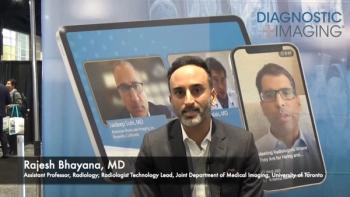
GE claims CT scans rival soft-tissue resolution of MR
A radically redesigned CT platform unveiled by GE Healthcare at the RSNA meeting produces images of soft tissue that rival those taken using MR, according to GE executives, who are framing the platform as a wholly new breed of CT scanner.
A radically redesigned CT platform unveiled by GE Healthcare at the RSNA meeting produces images of soft tissue that rival those taken using MR, according to GE executives, who are framing the platform as a wholly new breed of CT scanner.
A work-in-progress in both technology and name, GE's new HD (high definition) CT produces detail never before seen in CT. HD scans reveal soft tissue in the bowel, bladder, and prostate; liver vasculature and muscle stratification; brain aneurysms and even the fine mesh of stents implanted to stabilize aneurysms.
"The old way of CT was to produce the same image quality but with more slices," said Brian Duchinsky, general manager of global CT at GE Healthcare. "What we've done is to change the image clarity to see a whole new type of image."
The new platform uses a totally reengineered imaging chain. The x-ray tube is redesigned to shape the focal spot to suit the target: head, chest, abdomen, and legs. Enhanced data acquisition systems optimize information handling using advanced reconstruction software and hardware. A new detector material, of which 98% is composed of the gemstone garnet, responds 150 times faster to the light created by x-ray strikes on the detector and cuts afterglow to one-tenth the previous time, substantially reducing signal noise.
"This cuts out a lot of the artifacts found in traditional CT imaging," said Dominic P. Smith, general manager of molecular imaging, CT marketing, and advanced applications. "Beam hardening goes away."
The platform also features Volume Shuttle, which synchronizes the patient table and detector to widen the area of coverage, covering blood perfusion of the brain, heart and lungs, or liver. Moving the patient back and forth and gating the data acquisitions can dynamically capture a swath 25 cm wide.
GE has developed a suite of reconstruction techniques to cut dose. They are catalysts for the adoption of technology that GE executives describe as being as fundamentally different as multidetector CT.
Newsletter
Stay at the forefront of radiology with the Diagnostic Imaging newsletter, delivering the latest news, clinical insights, and imaging advancements for today’s radiologists.




























